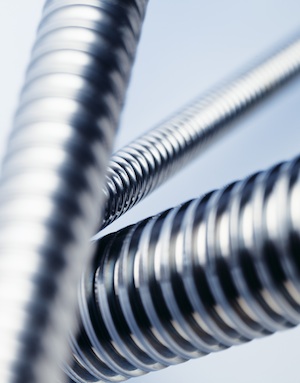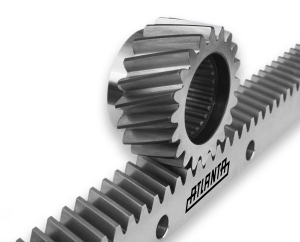Ballscrew Drives

ATLANTA Drive Systems, Inc. has a complete range of precision-rolled ballscrew drives for applications requiring precise positioning and repeatability. These drives can be used for duty cycles up to 100%, with high forces, linear speeds and efficiency.
The ballscrews and nuts all have right-hand threads. We can also offer bearing blocks for supporting the ballscrew.
These drives are perfect for a wide range of applications, including axis drives requiring precise positioning & repeatability, pick & place robots, CNC routers and material handling systems. Industries served include Material Handling, Automation, Automotive, Aerospace, Machine Tool and Robotics.
- Product Range
- Selection
| Diameter d | Lead | Ballscrew | Ball Nut | Dynamic Load Capacity C |
Static Load Capacity Co |
|---|---|---|---|---|---|
| 16 mm | 5 mm | KGS-1605 | KGF-1605 | 2,091 lb. | 2,945 lb. |
| 10 mm | KGS-1610 | KGF-1610 | 3,462 lb. | 5,957 lb. | |
| 20 mm | 5 mm | KGS-2005 | KGF-2005 | 2,361 lb. | 3,732 lb. |
| 20 mm | KGS-2020 | KGF-2020 | 2,361 lb. | 3,732 lb. | |
| 50 mm | KGS-2050 | KGF-2050 | 4,047 lb. | 5,530 lb. | |
| 25 mm | 5 mm | KGS-2505 | KGF-2505 | 2,766 lb. | 5,058 lb. |
| 10 mm | KGS-2510 | KGF-2510 | 2,968 lb. | 5,688 lb. | |
| 20 mm | KGS-2520 | KGF-2520 | 2,921 lb. | 5,238 lb. | |
| 25 mm | KGS-2525 | KGF-2525 | 3,755 lb. | 7,239 lb. | |
| 50 mm | KGS-2550 | KGF-2550 | 3,463 lb. | 7,126 lb. | |
| 32 mm | 5 mm | KGS-3205 | KGF-3205 | 4,834 lb. | 11,083 lb. |
| 10 mm | KGS-3210 | KGF-3210 | 7,509 lb. | 12,252 lb. | |
| 20 mm | KGS-3220 | KGF-3220 | 6,678 lb. | 13,444 lb. | |
| 40 mm | KGS-3240 | KGF-3240 | 3,350 lb. | 7,284 lb. | |
| 40 mm | 5 mm | KGS--4005 | KGF--4005 | 5,351 lb. | 14,185 lb. |
| 10 mm | KGS-4010 | KGF-4010 | 8,544 lb. | 15,534 lb. | |
| 20 mm | KGS-4020 | KGF-4020 | 7,487 lb. | 17,108 lb. | |
| 40 mm | KGS-4040 | KGF-4040 | 7,869 lb. | 22,908 lb. | |
| 50 mm | 10 mm | KGS-5010 | KGF-5010 | 15,446 lb. | 35,035 lb. |
| 20 mm | KGS-5020 | KGF-5020 | 13,490 lb. | 30,641 lb. | |
| 63 mm | 10 mm | KGS-6310 | KGF-6310 | 17,086 lb. | 44,290 lb. |
Selecting the right ballscrew drive depends on many things, including accuracy and load requirements, support type, design constraints, and cost. They are typically selected based on the peak cycle forces, which usually happen during accelerations and decelerations.
These cycle forces depend on the weight being moved, the speed vs. time profile for the cycle, the friction of the axis bearings, and any other external forces acting on the axis.
